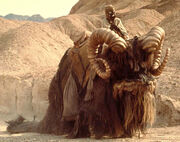Banthas are large, shaggy, and highly adaptable bovines found on many planets, most notably Tatooine. Tusken Raiders typically use them as mounts.
Anatomy and appearance[]
Banthas can go many weeks without food, and can survive in many extremes of climate and environment, making them prized agricultural commodities. All bantha subspecies share common characteristics, including two curving horns, fur, and prehensile tongues. Bantha are large, a common specimen being anywhere from 2 to 3 meters tall, and weighing up to 4,000 kilograms. They are also extremely long lived, typically 80 to 100 years old at time of death.

A bantha's tongue in detail.
An interesting anatomical feature of the bantha is it's long, flexible tounge. It is highly sensitive, structurally complex, dextrous, and extremely strong. It also has olfactory glands. Among other things, the tongue can be used for holding objects and inter-bantha communications. Banthas are highly intelligent and social creatures that travel in herds of up to 25 individuals. Every herd is led by a matriarch, the oldest and strongest female. If the matriarch becomes too old, she will usually relinquish control of the herd to the next oldest. If the herd becomes too large, it will split; the new herd will be led by the second oldest female.
Bulls tend to be slightly larger than cows and both genders grow a pair of spiral horns. Most female banthas achieve just a single spiral during their lifetimes, while a male cane achieve two full spirals before its death. The distinctive spiral horns of the bantha grow at the rate of a knob each year. Thickness and condition of the horns are an indication of the bantha's health and environment.
Behavior[]
Bulls fight each other by butting heads in ritual combat. The spirals on their horns can cause the pair to become entangled, which almost always means death for both banthas, as the pair will soon collapse from exhaustion and eventually succumb to death by dehydration.
Banthas also have a curious fascination with the bones of their ancestors, often gathering them into areas known as "graveyards" and fondling them. Mothers who have lost a calf have been known to carry the body many kilometers to such places.
Range and population[]
While the origins of the bantha are unknown, every world on which it exists lay claim to it as being its homeworld. Besides Tatooine, banthas are also found on Kashyyk, Killia IV and the moon Ohma-D'un. The bantha population on Kashyyyk presumably evolved from specimens brought back by Wookiee traders. The Kilian Bantha was adapted for living in the mountainous regions of Kilia IV. Swamp banthas were brought to Ohma-D'un to help colonize the moon. Feral banthas were also found on Talasea where they developed a mean personality and roamed the forested world at will.
Bantha subspecies[]
Aside from the common bantha, two other varieties have been identified on Tatooine: the dwarf bantha and the dune bantha. The dwarf bantha is much smaller, more skittish and shy; sure-footed, it lives in the canyons and cliffs of the remote, outer desert. The dune bantha is rangier, more slender, and less furry; it lives in the equatorial zone and can survive very high temperatures and the relative unavailibility of water.
On the Wookiee homeworld of Kashyyyk, the banthas that evolved there can be classed as a seperate subspecies. Kashyyyk banthas are much larger than the banthas on Tatooine, and have slightly shorter fur.
The Killian bantha, adapted to the planet Killia IV, have thicker and longer fur and are better adapted to living in mountainous regions.
The swamp bantha is a subspecies of bantha that was brought to the moon Ohma-D'un. It is smaller and less hairy than its desert relatives. The swamp bantha was also known for eating almost any plant.
Relationship with other species[]
The bantha was domesticated on most worlds and are used for pulling heavy loads, transportation and even as war beasts. The meat and hide of the bantha is much sought-after throughout the galaxy. Most banthas bred in captivity are trained as beasts of burden, and most of these are bred for desert environments. Noted for their docility, the dwarf race (also referred to as "miniature banthas") make amiable pets.
Tusken Raiders[]
The bantha was an integral part of Tusken culture on Tatooine.

A Tusken Raider rides a bantha.
When a Tusken Raider child reached the age of seven he or she was ceremonially presented with a bantha of the same age as a companion-for-life. The youth learned to care for the creature, and the two built a mystical bond. When the bantha reached maturity, the male Tusken Raider would saddle his companion and ride it into the desert for adult initiation ceremonies.
When Tuskens married, the couple's banthas would also mate. Often, the resulting calf would be of the same sex as the Tusken child.
The banthas of Tatooine were known to form deep bonds with the Tusken Raiders of the planet and often committed suicide if their riders were to die first. Banthas that died naturally were placed in vast graveyards, which other banthas treated with a kind of ceremonial reverence.
Trivia[]
- The name of the bantha may have come from the banth, a similar large mammal from Edgar Rice Burrough's Barsoom novels.
- In the original version of A New Hope, the bantha was played by a trained elephant, named Mardji, in a fur costume. In some cases, Mardji's trunk can be barely visible beneath the bantha costume.




